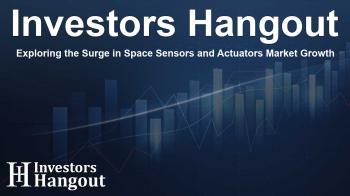Exploring the Surge in Space Sensors and Actuators Market Growth

Overview of Space Sensors and Actuators Market Growth
The Space Sensors and Actuators Market has shown remarkable growth and is expected to reach USD 10.9 billion by the end of the forecast period. In 2024, the market was valued at USD 3 billion. This growth trajectory is supported by a wave of technological advancements that focus on enhancing functionality and reliability while keeping components compact, which is essential for the demanding environments in space missions.
Technological Advancements Driving Market Evolution
Recent innovations, such as piezoelectric actuators and MEMS (Micro-Electro-Mechanical Systems)-based sensors, are game-changing. These technologies are designed to enhance performance while minimizing size and weight, which is crucial for efficiently managing space missions. With missions that aim to explore celestial bodies, these new tools are invaluable, demanding precise telemetry, thermal control, and engine management capabilities.
The Role of Investments in Market Expansion
A surge in investments from both government entities and private companies is leading the charge in the space sensors and actuators market. Ambitious exploration projects—like those focused on Mars and asteroids—require state-of-the-art sensors and actuators to support intricate operations in extremely harsh conditions.
Market Segmentation: Sensors vs. Actuators
The space sensors and actuators market is divided into two primary segments: sensors and actuators. The sensors segment is predicted to witness a compound annual growth rate (CAGR) of 14% throughout the forecast period. Innovations have enabled the creation of lightweight and precise sensors adept at functioning in the unforgiving environment of space. Among these, MEMS sensors are rapidly gaining popularity due to their compactness and precision, making them well-suited for use in modern spacecraft.
Focus on Commercial Applications
Within the market, the commercial segment has emerged as the front-runner, generating USD 2.4 billion in revenue in 2024. This rise is largely attributed to increased investments in satellite technologies and the involvement of private space enterprises. Small satellites, particularly CubeSats, have become the trend for various applications, including Earth observation and telecommunication, leading manufacturers to innovate cost-effective solutions that provide real-time data for climate analysis and disaster management.
Performance Trends in North America
North America accounted for a significant 43.4% of the space sensors and actuators market in 2024. The region benefits from robust government funding for space exploration initiatives and a thriving commercial sector. These dynamics create a substantial demand for advanced sensing and actuation technologies, which are imperative for spacecraft control, environmental monitoring, and scientific investigation.
Competitive Landscape of the Space Industry
Several key players in the space sensors and actuators industry are making notable contributions. Firms like Airbus, Ametek, Honeywell, and Raytheon Technologies, among others, are leading the way in the innovation of technological solutions that cater to the growing needs of the space sector. Their efforts in developing advanced sensors and actuators have positioned them favorably in this rapidly evolving market.
Conclusion: The Future of Space Exploration Technology
The space sensors and actuators market is poised for transformative growth. With continuous innovation and a pressing need for reliable technologies, this market will continue to adapt to the requirements of modern space missions and commercial applications. Embracing these advancements will play a crucial role in shaping the future of space exploration and satellite applications.
Frequently Asked Questions
What is the projected market value of space sensors and actuators by 2034?
The market is projected to reach USD 10.9 billion by the end of 2034.
What are the main drivers of growth in this market?
Technological advancements, increased investments, and rising demand for innovative spacecraft control systems are key drivers.
Which segment is expected to grow the fastest?
The sensors segment is expected to grow at a CAGR of 14% during the forecast period, driven by advancements in technology.
What role does North America play in this market?
North America leads the market with a 43.4% share, fueled by government initiatives and a dynamic commercial space sector.
Who are the major players in the space sensors and actuators market?
Major companies include Airbus, Honeywell, Raytheon Technologies, and several others actively engaged in developing advanced solutions for space technologies.
About Investors Hangout
Investors Hangout is a leading online stock forum for financial discussion and learning, offering a wide range of free tools and resources. It draws in traders of all levels, who exchange market knowledge, investigate trading tactics, and keep an eye on industry developments in real time. Featuring financial articles, stock message boards, quotes, charts, company profiles, and live news updates. Through cooperative learning and a wealth of informational resources, it helps users from novices creating their first portfolios to experts honing their techniques. Join Investors Hangout today: https://investorshangout.com/
Disclaimer: The content of this article is solely for general informational purposes only; it does not represent legal, financial, or investment advice. Investors Hangout does not offer financial advice; the author is not a licensed financial advisor. Consult a qualified advisor before making any financial or investment decisions based on this article. The author's interpretation of publicly available data shapes the opinions presented here; as a result, they should not be taken as advice to purchase, sell, or hold any securities mentioned or any other investments. The author does not guarantee the accuracy, completeness, or timeliness of any material, providing it "as is." Information and market conditions may change; past performance is not indicative of future outcomes. If any of the material offered here is inaccurate, please contact us for corrections.
